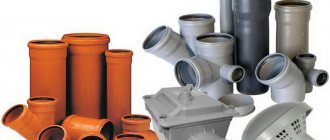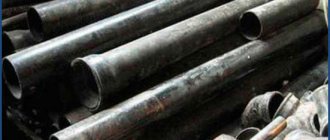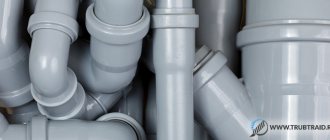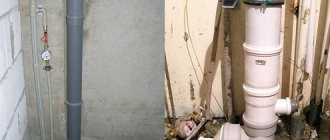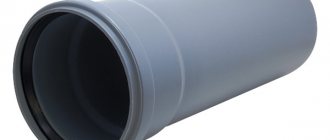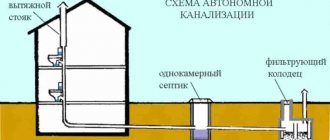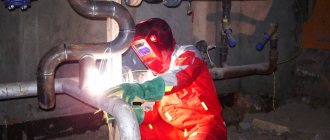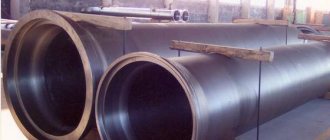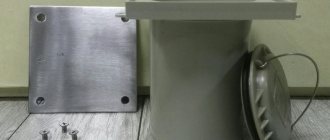The most complex and labor-intensive work involves the installation of cast iron sewers. It is reliable and durable, but has many negative indicators. Difficulties arise due to the large weight, fragility of the material, and the need to perform a rather complex procedure at each connection of parts.
This slows down the system build. However, the performance qualities of metal pipelines are quite high and allow one to put up with some inconveniences during installation. Modern drainage lines are made of plastic, but some types of industrial networks are still made of metal. Let's look at the features and specifics of installation in more detail.
Features of cast iron pipes
New plastic drainage system pipelines. They are cheaper, light weight and easier to assemble. All alternative options are used only in systems that operate in difficult conditions.
If the pipeline is cast iron, the sewer joints will have to be processed separately. Each connection requires caulking (this is what experts call the compaction procedure during assembly). This applies to socket parts equipped with special connecting elements. There are also products that are assembled using couplings. They are not equipped with connecting units, which simplifies production, but additional parts are required for installation. They are expensive, which increases costs and the overall cost of the network. The coupling method is used to install pressure-type cast iron sewers. It is widely used in industrial wastewater systems.
The system includes two groups of parts:
- pipes. These are straight elements that form straight extended sections of the network;
- fitting. These are parts designed for branching or turning channels. In addition, fittings are used for cleaning and other types of system maintenance.
Since the rules for laying networks were developed a long time ago, on metal pipelines, the basic requirements for installation work differ little from modern standards. Required to provide:
- line slope, which depends on the diameter of the pipes;
- tightness, no leaks;
- When laying, the sockets should be directed towards the starting (highest) point of the line.
Installation of sewerage from cast iron pipes is carried out at the stage of primary construction of buildings or structures. Later assembly of systems requires destruction of the finishing of the premises. Before assembly, it is necessary to calculate the network, draw up a diagram and a working drawing of the line. This is an important stage in the construction of the system, since working with metal elements is complex and requires effort and time.
Advantages and disadvantages
The advantages of cast iron drainage networks include:
- strength;
- ability to withstand high pressure and large external loads;
- low coefficient of thermal expansion;
- long service life;
- cast iron pipes are less susceptible to corrosion;
- low noise level.
Flaws:
- heavy weight When working with large diameter pipes, lifting equipment is required;
- connecting cast iron sewer pipes is complex and time consuming;
- cast iron is brittle. Assembly must be done carefully so as not to split the connecting elements;
- the surface of the material is rough, which promotes the growth of fatty deposits on the walls;
- the finished line is difficult to repair or replace individual elements.
The disadvantages of metal elements led to a transition to more convenient plastic lines. However, systems operating in difficult conditions and withstanding significant loads are still assembled from cast iron parts. If the assembly is done with high quality, the line can operate for up to 100 years or more, which makes the material relevant in the present day.
Dimensions
The question of the size of cast iron pipes deserves special attention. When it comes to plumbing, as well as sewerage, the size of the pipes is of great and even decisive importance. It is the diameter that determines where the product is used and how much liquid the pipe can carry per unit of time.
For example, a cast iron pipe up to 100 mm can only be used for internal sewerage, since if it is used when installing common risers, it will not withstand all the pressure and will simply clog. By the way, this is a very important point, which in many ways distinguishes sewer systems from water pipelines. If for some reason the latter becomes clogged, then the only inconvenience that households will face is a decrease in water pressure. However, the water supply system uses clean water, but the sewer system uses fecal water, so if a blockage occurs, the entire sewer system will become clogged and stop functioning.
- For internal sewerage, pipes with a diameter of 100 mm are sufficient, and for small sanitary units, products with a diameter of 50-70 mm are completely suitable - they are installed at the connection points of the bathtub, sink or toilet.
- For installation of risers, preference should be given to pipes measuring 150 mm.
- In external sewerage, a variety of sizes are used, for example, for medium branches they take pipes with a diameter of 150 mm, to fix several sections together they take 300 mm pipes, but for main systems you should purchase products with a diameter of 800 mm or more.
The current GOSTs contain tables in which you can find all permissible dimensions for pipes of each type.
How is caulking done?
Installation of cast iron sewer pipes is a complex and lengthy procedure. Each connecting element has to be processed separately, which slows down the assembly of the line. It is impossible to shorten or speed up the process, although experienced installers can work quite quickly. High speed is achieved by optimizing working time, using your own skills and experience.
Features of installation of cast iron sewerage (cast-iron-cast-iron connection):
- the pipe socket is put on the free end of the previously laid line;
- tow or a strand of resin is stuffed (caulked) into the gap between the walls of the socket and the free end of the other part. It is compacted with a special tool - a wooden spatula. Stuffing is done until the tow fills 2/3 of the height of the connecting element;
- the packing is treated with a sealant. It must be without impregnation so that the quality of adhesion of tow to cement does not deteriorate;
- the remaining free third of the socket is filled with cement mortar (in a proportion of 9 parts cement to 1 part water). Sometimes the solution is reinforced with asbestos-cement fibers in half the proportion;
- the solution is poured into the gap and compacted. Place a wet rag on top. So that cracks do not appear during hardening.
When assembling lines, cement mortar has recently been replaced with sealant. This speeds up the installation process, since the operation of mixing the solution is eliminated. However, the cost of modern materials is much higher than the price of cement, which increases the cost of constructing a drainage network.
General characteristics and types of pipeline
For the manufacture of products at metallurgical plants, high-strength cast iron is used, and the production process must fully comply with the requirements of GOST 6942-98. Cast iron pipes must meet the following parameters:
- Diameter - from 50 to 1200mm;
- Length - 2-7 m;
- Wall thickness - 6.7 - 31 mm.
Cast iron pipes have the following distinctive characteristics:
- Resistance to mechanical stress;
- High temperature resistance;
- Strength;
- High-strength cast iron provides wear resistance;
- Corrosion resistance;
- There is no need for additional sound insulation;
- Cast iron fittings are used to connect pipeline elements during installation, which significantly saves money on the purchase of materials;
- Fire safety;
- Long lifespan.
Non-pressure cast iron pipes
In order for the products to successfully resist corrosion, they are coated on both sides with petroleum bitumen. By the way, cast iron has the highest corrosion resistance among all types of metal. Also, the bitumen coating inside the product significantly reduces the roughness coefficient, makes the walls smooth and capable of allowing more liquid to pass through.
Cast iron pipe comes in the following types:
- VChShG - pressure;
- CHK - free-flow;
- SML - socketless;
- ChNR - bell-shaped.
Connection with plastic elements
The laying of cast iron sewer pipes is carried out according to the usual method. However, modern lines and plumbing outlets are usually made of plastic (PVC, propylene, polyethylene). The diameters of cast iron and plastic parts do not match, so special adapters are made for them. They are made in the form of rubber couplings, the outer diameter of which corresponds to the size of the cast iron socket, and the inner diameter fits the plastic parts. There are adapters for siphons, pipelines, parts for connecting pipes of different sizes.
Installation of the adapter is carried out in stages:
- the inner surface of the socket is covered with silicone sealant;
- install the adapter;
- A plastic part is inserted into the central hole. If it fits too tightly, you can apply a little liquid soap. This will make assembly easier.
Adapters for all possible connections are commercially available. The main demand is for elements for the transition of a 50 mm plastic pipe into a 110 mm cast iron tee, or for connecting corrugations to sockets.
Also read: Blowing from the sewer in the apartment: from the sink, why, is it normal or not, review
Elimination
Let's look at several of the most common causes of leaks and select the most acceptable option for eliminating it for each of them. So, it's a blockage.
- If a blockage has formed in the sewer pipes located on the territory of your apartment, then eliminating it is quite easy. You will need a plumbing cable, with which you, after turning off the water, will clear the blockage. As a rule, the main element of a pipe plug is frozen fat. This is what you will soften with a cable. Then, when the water supply is restored, the pieces of fat will be safely washed down the drain.
- If you live on the first floor, and the blockage occurs somewhere in the basement, then everything will happen much worse. All sewage water from the upper floors will flow into the basement and, encountering a plug, return to your apartment. And here no sewer plugs will help. Dirty water will flow from the toilet, from the sink, and even from the bathroom.
In this case, all you can do is call the emergency service, and before they arrive, go down to the basement and open the riser inspection cover. The blockage, of course, won’t go anywhere, but sewage will stop flowing into your apartment.
Appearance of cast iron revision
Just be sure to leave the cover and its fasteners in a visible place so that emergency personnel will have no problem getting it back in place.
Repair
Most problems that occur in metal pipes are cracks or chips in the bell. They appear for various reasons, but the main ones are careless storage or installation of cast iron sewer pipes. Repairing these parts is difficult. The material cannot be welded, and sealing cracks with acid or sulfur are dangerous procedures that require experience and skill. Therefore, most often the problem area is wrapped with a plaster, or a clamp is installed. A crack in a material such as cast iron is not yet a sign of pipe failure. If it is strengthened and sealed, and mechanical loads or impacts are eliminated, the part can last for a very long time. A complete replacement of a section of the system is rarely done, since it is necessary to find a feed-through coupling of the required size, which are rarely found on sale.
Types of common types of sealants, their properties, rules of use, pros and cons
In order to make quality repairs and not return to them for as long as possible, you need to choose the optimal method for sealing the seam in the sewer. Each type of sealing material has its own scope of use. In addition, the operating conditions of the system and the economic feasibility of using a particular option should be taken into account.
Types of common sealants
Metal polymers
Metal polymers are an innovative technology for pipe repair. It is also suitable for high pressure pipelines. Sewage systems operate by gravity, without pressure. Therefore, the use of metal polymers is generally not economically feasible. However, in critical areas, in systems operating at the limit of design capacity, the use of this method is justified. In this way you can seal the joint of any sewer pipe.
Materials intended for sealing
Sealing tapes
Both regular and foil tapes are available
Self-adhesive tapes, which have anti-corrosion properties and are specifically designed for sealing pipe joints, are one of the newest modern means of sealing. They have many positive properties:
- Self-adhesive anti-corrosion tapes are quite highly effective and easy to use.
- Sealing films, thanks to their high-strength polyethylene base, are characterized by good operating properties.
- They are used to provide protection for various types of pipelines as a whole, as they have dielectric and anti-corrosion properties. In addition, sealing films are used to seal linear elements of sewer pipes.
- Sealing using tape is possible not only when sealing the joints of sewer pipes, but also when sealing plugs, taps, turning corners, bends, etc.
Before sealing a sewer pipe using sealing tapes, remember that sealing is carried out in the following sequence:
- To apply the tape, surface preparation is necessary: it must be dry, dust-free and clean;
- it is necessary to ensure constant tension of the tape that is wrapped around the pipe, and also to prevent the appearance of folds and wrinkles;
- the tape must be applied, providing an overlap of 50%, in a spiral, as a result of which the entire surface to be insulated will necessarily be under two layers of film.
Sealing sequence (some tapes require primer treatment)
Pro tip:
Such films are not resistant to UV radiation. That is why, when placing sewerage pipes in an area that is exposed to the sun, an additional protective layer must be provided over the film.
Silicone sealants
Silicone is the most well-known material for sealing
Silicone rubber forms the basis of silicone sealants. Silicone sealants in general are a composition of different substances that provide high sealing qualities. Silicone sealants have good adhesion to surfaces, without requiring them to be pre-treated with primers.
Based on the type of hardener in its composition, sealant for sewer pipes made of silicone is divided into:
- Acid. Acidic silicone sealants are quite inexpensive, although they cannot be applied to some surfaces that can interact with acids.
- Neutral. In this regard, neutral silicone sealants are considered more universal.
Using silicone sealants, it is possible to seal the joints of sewer pipes:
- made of metal;
- made of plastic.
After vulcanization, the silicone paste turns into a substance that is similar in properties to rubber. The vulcanization process of silicone sealant involves moisture in the air.
Pro tip:
Squeezing out the sealant is quite simple - using a mounting gun. If it is not available, you can use an ordinary hammer by inserting its handle into the tube and pressing as if on a piston.
How to squeeze out silicone sealant without a mounting gun
Sealing sewer pipes with other sealants
In addition to the above means, sealing sewer pipes is also done using other means:
- Epoxy resin - at home, like glue based on it, serves as the most common means used for connecting sewer pipes.
- Portland cement is a fairly common component of most sealing mixtures - it is used in the preparation of asbestos-cement mixtures and when caulking the socket joints of cast iron sewer pipes.
- Petroleum bitumen and asphalt mastic will be required to prepare the fill, which is intended for sealing joints and filling sockets of ceramic pipelines.
- Hemp or jute rope, resin strand - are used when sealing the sockets of cast iron and ceramic sewer pipes. Using a combination of rope and resin impregnation would be preferable.
- Technical sulfur - is used to ensure tightness, mainly at the joints of cast iron sewer pipe sockets. Before pouring it into the joint gap, it should be crushed and then heated until melting.
Technical sulfur can also be purchased in crushed form.
With such an abundance of materials, the question is unlikely to arise: “How to cover a sewer pipe?”
Silicone sealant
Sealing of joints and cracks in cast iron sewers is also carried out by other specialized means. These include silicone sealant, which is characterized by excellent adhesive properties regardless of the type of surface.
Silicone sealants are divided into:
- acidic;
- neutral.
The first products are not recommended to be applied to a surface that comes into contact with an aggressive environment. Neutral sealants are universal products.
Silicone sealant is applied to the damaged surface using a mounting gun. The vulcanization process is facilitated by moisture in the air. Silicone paste turns into a substance that has similar characteristics to rubber.
As alternative options for sealing cast iron pipes at home, the following are used:
- Portland cement;
- jute or hemp rope;
- epoxy resin;
- technical sulfur.
Relining
This type of repair is simpler.
A PE pipe of smaller diameter is placed inside the damaged pipe. The new pipe does not leak. The throughput capacity is not reduced, since the new pipe, unlike the old one, has a smooth inner surface.
Relining
Repairing your sewer system cannot be put off until later. Repairing defective and rotten pipes is not recommended.
A complete replacement of the pipeline is required. Using an old cast-iron system, the likelihood of leaks and blockages increases every day, and the possibility of flooding the neighbors below with drains increases, followed by expensive repairs to their premises at your expense. Timely replacement of the sewer pipeline will save you from troubles.
https://youtube.com/watch?v=aGqDnqSUdP8rel%3D0%26amp%3Bcontrols%3D0%26amp%3Bshowinfo%3D0
- experttrub.ru
- pikucha.ru
- stroy-block.com.ua
- vse-o-trubah.ru
Scope of application
For those who decide to resort to the help of this super product to carry out the sealing process in the bathroom, there is no question of choice. Silicone sealant is used, as a rule, to create seams between plumbing fixtures and the walls of the room so that moisture does not get into these gaps. Transparent plumbing material is used for connections between sewer and water pipes. Sometimes a special FUM tape is also suitable for these works.
One type of sealant for sewer and water supply pipelines is epoxy resin. But first it is mixed with a hardener. In this case, it is imperative to follow the instructions for creating such a sealed product.
As for the treatment of cast iron pipes, standard plumbing sealant is used for them.
There are actually a lot of areas for using silicone and polypropylene compounds in an apartment. And we are talking here not only about the treatment of a water block, a bathroom, and so on. Sometimes caulk is used to seal the seams between the window frame and the opening.
It is very convenient to use white sealant when installing a toilet
This type of plumbing contains a large number of points that are worth paying special attention to. Thus, the water hose that supplies liquid to the tank has a unique shape, which can be sealed either with FUM tape or neutral silicone sealant
To seal a pipe duct in a cable duct, you can use either standard neutral or acidic sealants, or Portland cement, which is more powerful in its properties and functions.
Execution of the process
Each type has its own technological features in application. Liquid ones are applied and left until completely dry, solid ones are driven into the joints. The most popular and requiring minimal knowledge is sealing with flax fibers. Implementation technology includes performing actions in the following sequence:
Stripping, painting and wrapping pipes
- The first step is to clean the part.
- Then paint the carving.
- We leave the paint. You need to wait until it dries a little, but not completely. It should stick to your hands a little.
- After this, you can wind the fiber onto the thread. This should be done as tightly as possible for better reliability against leakage.
- Care should be taken to ensure that the winding is uniform. It should be applied in a thin layer.
- Next, the fiber is dyed and a second layer of flax is applied.
- After this, sealing can be considered complete.
Instructions for sealing using tapes include the following steps:
- The surface is cleaned of dust.
- Maximum drying.
- Tape is wound onto the thread. To avoid wrinkles on the part, you need to pull the skein, as if pulling it towards yourself, and wind it in this position.
- It is necessary to apply two layers of tape for greater reliability.
